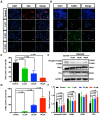TPGS-1000 exhibits potent anticancer activity for hepatocellular carcinoma in vitro and in vivo
- PMID: 31986488
- PMCID: PMC7053644
- DOI: 10.18632/aging.102704
TPGS-1000 exhibits potent anticancer activity for hepatocellular carcinoma in vitro and in vivo
Abstract
D-alpha-tocopheryl polyethylene glycol 1000 succinate (TPGS1000) is the most active water-soluble derivative of vitamin E and has been widely used as a carrier of solvents, plasticizers, emulsifiers, absorbent agents and refractory drug delivery systems. However, its anti-hepatocellular carcinoma (HCC) properties have not been explored. HCC cells were treated with different concentrations of TPGS1000. Cell survival was tested by CCK8 assay, and cell migration was tested by wound healing and Transwell assay. EdU staining verified cell proliferation, and signalling pathway was assayed by Western blot analysis. The BALB/c-nu mouse xenograft model was established to test HCC cell growth in vivo. In vitro TPGS1000 significantly inhibited the viability and mobility of HCC cells (HepG2, Hep3B and Huh7) in a dose-dependent manner. Cell cycle analysis indicated that TPGS1000 treatment arrested the HCC cell cycle in the G0/G1 phase, and induction of cell apoptosis was confirmed by TUNEL and Annexin V-7-AAD staining. Further pharmacological analysis indicated that collapse of the transmembrane potential of mitochondria, increased ROS generation, PARP-induced cell apoptosis and FoxM1-p21-mediated cell cycle arresting, were involved in the anti-HCC activity of TPGS1000. Moreover, treatment in vivo with TPGS1000 effectively impaired the growth of HCC xenografts in nude mice.
Keywords: TPGS1000; apoptosis; hepatocellular carcinoma; malignancy; migration.
Conflict of interest statement
Figures






References
Publication types
MeSH terms
Substances
LinkOut - more resources
Full Text Sources
Medical
Research Materials
Miscellaneous

